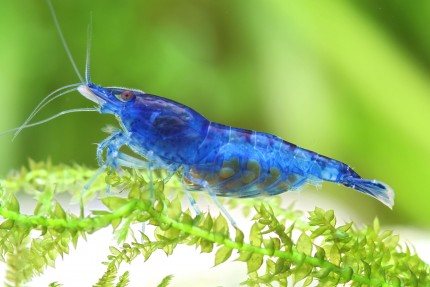- Item no: 5551
Fast delivery times
All products are in stock with us!14 years of breeding experience
Let our team of experts advise you!High customer satisfaction
from over 3,000 reviews "The Chocolate Apricot Crab from the Vogelkop Peninsula (Papua/Indonesia) is a beautiful color variation of Cherax holthuisi. With its dark brown top color and bright orange accents, it looks like it is glowing from within. The small eyes suggest it may be a cave dweller. When measured without claws, the Chocolate Apricot Crab reaches a body length of about 10 to 12 inches. The sexually mature male has its gonopores (the sexual openings) at the base of the fifth pair of walking legs, the females also have sexual openings, in them they are located on the third pair of walking legs.
Cherax holthuisi is considered quite compatible and peaceful, but should not be socialized with crayfish of other species, crabs or large-armed shrimp under any circumstances, as this can lead to high stress. American crayfish also carry the risk of undetected infection with crayfish plague, which would inevitably kill Cherax holthuisi. It must also not come into contact with water in which American crayfish are kept! Socialization with peaceful fish is possible, but it may happen that Cherax holthuisi nips or even chases. It eats sick and dead fish, as well as snails and mussels. Shrimp are usually left in peace.
A pair of the Chocolate Apricot Crayfish feels comfortable in an aquarium of 80 cm or more in length, provided it is well structured with root wood and stones so that the animals can hide well. Crayfish caves made of clay pottery and coconut caves are also well suited. The chocolate apricot crab likes to dig its own hiding place. Therefore, the decoration must be placed in such a way that it does not tip over and cannot be undermined. Basically Cherax holthuisi does not go for plants, although it may make an exception for soft plants like Pogostemon helferi. Species with hard foliage such as Anubias or Congo fern or fast growing plants such as waterweed or hornwort have a good chance of not being eaten. The water temperature should be between 20 and 25 °C. Make the aquarium absolutely escape-proof. Cherax holthuisi like to climb well and squeeze through any gap! The chocolate apricot crayfish tends to be crepuscular and nocturnal, but it will also emerge during the day once it is well acclimated.
Adolescent Cherax holthuisi are omnivores, feeding not only on vegetable but also animal food. Here we recommend our Natureholic Crayfish Feed in addition to frozen food and the Natureholic Protein Feed. FD food is also suitable for targeted protein supplementation. Older chocolate apricot crayfish then feed predominantly vegetarian. In addition to green food such as spinach or nettles , unsprayed vegetables are also suitable. Brown autumn leaves are a very suitable permanent food that can remain in the aquarium. A diet too rich in protein can lead to dangerous moulting problems in adult Cherax!
Breeding the Chocolate Apricot Crayfish is not difficult. The female nurses between 40 and 80 dark eggs under her abdomen and carefully fans and cleans them. It takes 7-9 weeks for the young crayfish to hatch. They remain under the mother's tail for a few more days and then are immediately independent. We recommend a decent layer of brown fall foliage for successful rearing. The young of the Chocolate Apricot Crayfish grow relatively slowly and are quite cannibalistic among themselves.
Our food recommendation: Freshwater crayfish have a very varied diet in the wild. The Natureholic Crab Feed Sticks contain in a biologically balanced form only those ingredients that these crayfish in this or similar form to their natural food spectrum. This naturally supports and promotes moulting, growth and reproduction. Due to their protein content they are ideally suited for omnivorous crayfish of the genera Procambarus, Cambarus, Cambarellus, Astacus and the Cherax crayfish from Australia, which are basically omnivores that like to eat animal as well as vegetable food. The crayfish of the genus Cherax from Papua also like to eat a portion of animal food when they are young, but later they switch predominantly to plant food.
Our plant recommendation: Use the following for planting NatureHolic InVitros. These are free of snails, planarians and other unwanted co-inhabitants. Also free of algae spores, bacteria and fungi.
Expert Tip: We recommend for fish keeping the NatureHolic 3 Phase Liquid. The care set offers the best all-round protection for your animals. It ensures optimal conditions for successful breeding and keeping.
| Scientific name | Cherax holthuisi (Lukhaup & Pekny, 2006) |
| German Name: | Chocolate Apricot Crab |
| Difficulty level: | suitable for beginners |
| Origin/Distribution: | Vogelkop Peninsula, Papua/Indonesia |
| Coloration: | brown-orange |
| Age expectancy | 2 to 5 years |
| Water parameters: | GH up to 25, KH up to 20, pH 6.5 to 7.5, temperature 20 to 25 °C |
| Tank size: | from 80 l for a pair, but we recommend a size of at least 112 l for successful breeding |
| Food | brown autumn leaves, Natureholic crayfish feed, frozen food, vegetables, green food (spinach, nettle), protein food |
| Propagation | not difficult, after seven to nine weeks 40 to 80 young crayfish hatch |
| Behavior | compatible |
| Socialization | with shrimps, possibly with peaceful medium sized fishes |
| Further information | Sex differences crayfish, shrimp, crayfish, snails & mussels feed properly, Cherax aquarium crayfish - keeping in the aquarium |
- Item no: 5551
- EAN No.: 7427061471298
Entdecke die Garnelio Welt!
Garnelio gehört zu den größten Onlineshops für wirbellose Aquarientiere weltweit.
Viele Artikel gibt es exklusiv nur bei uns im Shop.



























